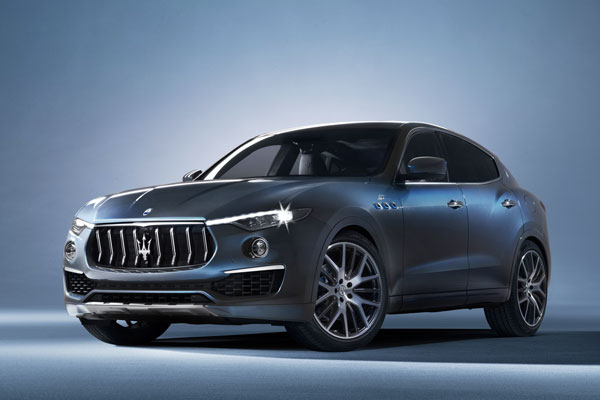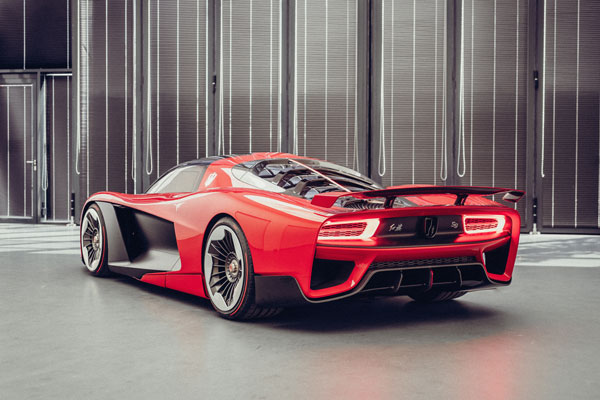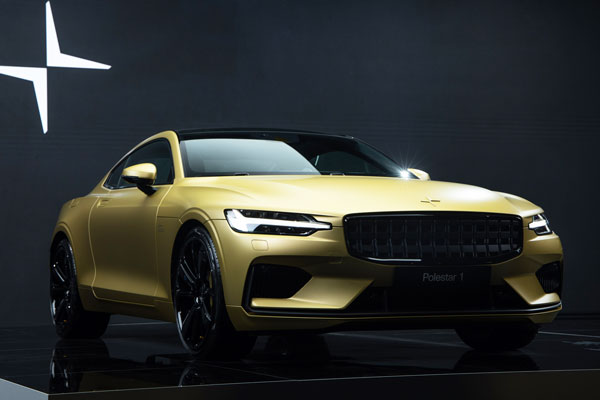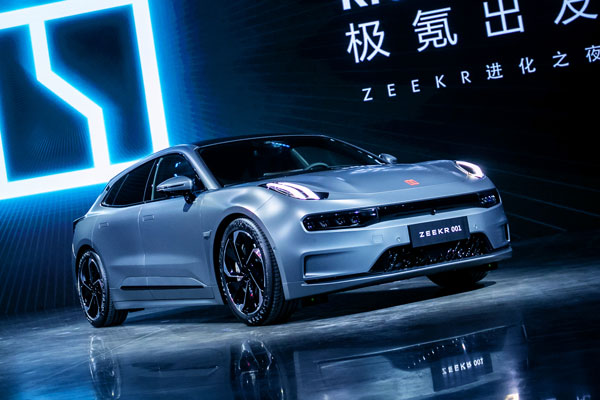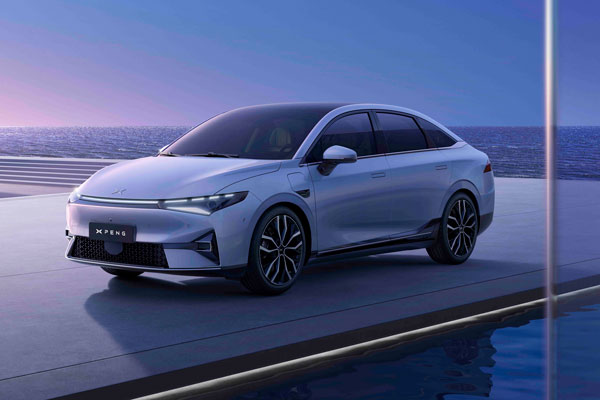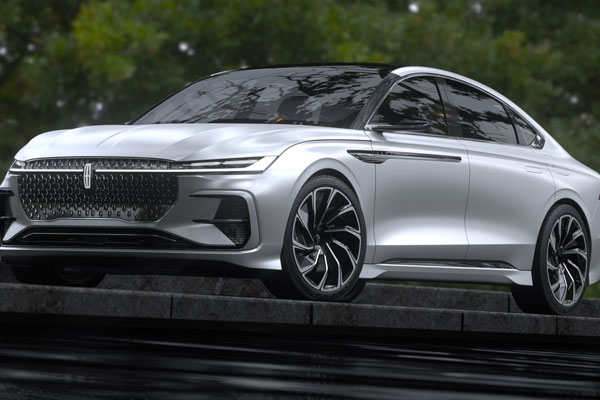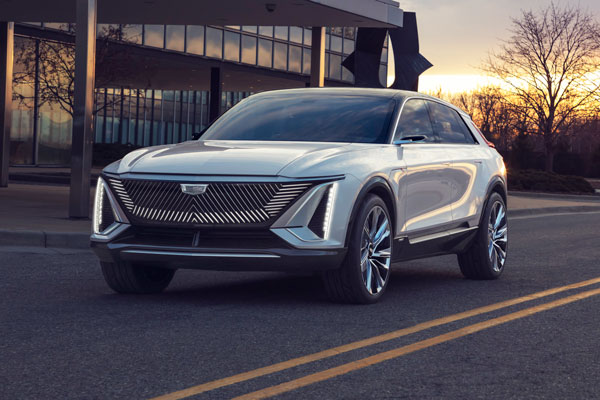Auto Shanghai 2021: Spotlight on an Electric Future
China is pretty much at the heart of the automotive world at present.
The country is the world’s biggest car market, with some 20 million vehicles sold there in 2020 (compared to around 15 million in the U.S., and a smidge over 900,000 in Australia).
If you focus just on electrified vehicles, China is the biggest marketplace too. From January to March 2021, production and sales of new energy vehicles (plug-in hybrid, battery-electric, and fuel-cell vehicles) in China reached 533,000 and 515,000 units respectively. Those are big numbers.
The upshot of that sort of market clout is that when automotive news comes out of China, the rest of the world takes notice.
In April this year, the 19th Auto Shanghai motor show was held, and with the theme of ‘Embracing Change’ it was no surprise to find that electric vehicles and advances in autonomous technology and connectivity were to be found everywhere.
Some companies took the opportunity to announce quite significant strategic moves. Toyota, for example, announced it was to make a big shift into battery-electric vehicles (BEV) with a sub-brand called BZ, and revealed its BEV concept, the bZ4X.
A seemingly endless number of electrified vehicles made their debuts at the show, many that are being manufactured with the Chinese market and consumer in mind, and which will be exclusive, for now at least, to that nation.
Chinese brands such as NIO, Li Auto, XPeng, and a host of others, all presented new vehicles, with SAIC Motor – China’s largest automotive manufacturer and the company behind brands including Maxus (LDV in Australia) and MG – showcasing more than 160 vehicles, including 10 debuts. It’s not hard to believe that as the EV market grows, these names and others from China will become serious players globally.
Today’s more recognisable global brands (often in partnership with Chinese companies) such as Ford, GM, Audi, VW and others were also in on the action in Shanghai, and over the following pages we take a look at a handful of the vehicles that caught our eye.
Maserati Levante Hybrid SUV
Maserati has unveiled the Levante Hybrid SUV at the Auto Shanghai show.
It is the company’s first electrified SUV and comes after the launch of the Ghibli Hybrid last year.
The all-wheel-drive (AWD), 8-speed automatic hybrid combines a 4-cylinder, 2-litre turbo petrol engine with a 48-volt Hybrid system with eBooster and BSG (Belt Starter Generator).
It is a ‘mild’ hybrid, not a plug-in, and so energy is recovered during braking and deceleration by the BSG to help charge the battery. This then provides energy to the eBooster which, in turn, works in tandem with the turbo to sustain engine power.
Maximum power output is 246kW with torque of 450Nm delivered from 2,250rpm. Top speed is over 240km/h and acceleration from 0 to 100 km/h comes in six seconds.
Maserati says that going with a mild hybrid option rather than a plug-in came down to performance – the BSG 48-volt together with the eBooster offers the right combination of performance and efficiency, while a plug-in would have too much weight and jeopardise the car’s performance characteristics.
The Levante Hybrid launch version comes with a new metallic tri-coat colour called Azzurro Astro and some exterior and interior details are highlighted in blue, the shade chosen to identify Maserati’s hybrid cars. On the exterior, these include the three side air ducts, the brake calipers and the C-pillar logo. The same blue shade appears inside the car on the embroidered seams of the seats.
The Levante Hybrid comes with the Maserati Connect program, meaning the car is connected at all times and allows, amongst other things, for the driver to be alerted when a service is due.
With a Smartphone or Smartwatch, drivers can stay in contact with their car via the Maserati Connect App, and this is also possible from home via a virtual personal assistant such as Amazon Alexa or Google Assist.
Hongqi S9 Supercar
Silk EV, an international automotive engineering and design company, and China’s FAW car manufacturer, announced a joint venture to develop a series of ultra-luxury, high-performance, new energy sports vehicles.
The launch of the joint venture follows the announcement by the companies in May 2020 of their plans to partner on automotive, artificial intelligence, connectivity, battery solutions, and IoT development.
The Silk-FAW Joint Venture plans to launch new fully electric and hybrid luxury models under the Hongqi ‘S’ series – and the first model of this series will be the ultra-luxury hypercar, the S9, which will be manufactured in Italy where Silk EV has its headquarters.
A concept of the S9 first appeared in 2019, and the car is an absolute beast, with an astonishing 1044kW on tap thanks to a V8 engine/battery hybrid system. The companies claim a top speed of 400km/h and a 0-100km/h time of 1.9 seconds.
Details beyond that are scarce, but who cares . . . the S9 looks fantastic and performance is clearly going to be scorching. That’s a good start.
Polestar 1 Special Edition
Polestar revealed a special version of its Polestar 1 electric performance hybrid as the end of production for the model draws closer. The limited-edition has a lightweight body made from carbon fibre-reinforced polymer, twin rear electric motors with torque vectoring, and high-performance components including Akebono brakes and Öhlins dampers.
It features a bespoke matte gold exterior paint job with matching callipers and black wheels while, on the inside, there is colour-matched gold stitching. A maximum of 25 of the model will be built.
Power for the Polestar 1 comes courtesy of a 2-litre, 4-cylinder twincharger (supercharged and turbocharged) engine that drives the front wheels, paired with the two electric motors at the rear wheels. With a combined power output of 454kW and 1,000Nm of torque, plus a 34kWh battery set-up that also allows for a pure electric driving range of 124km, Polestar 1 is a performance car that can be driven as a full EV in daily use, while also doubling as a long-distance GT.
Mercedes-Benz EQB
A few days on from unveiling its top-of-the-range EV model, the EQS (see page 80), and four months on from revealing the EQA small SUV, Mercedes-Benz took the opportunity presented by Auto Shanghai to take the wraps off the third model in its EQ brand of all-electric vehicles – the EQB SUV.
The seven-seater will have a China-specific version which come to market in China later this year. A European version will also be launched in 2021, and in the USA the EQB will arrive in 2022.
Mercedes says the EQB range will include several models with front-wheel and all-wheel-drive options and various power ratings. Batteries will start at 66.5kWh capacity, but a long-range version is planned.
The European flagship EQB 350 4MATIC version will deliver over 200kWkW and range is claimed at 419km (on the WLTP standard).
The EQB can be charged at up to 100kW at a DC fast-charging station (Mercedes says a 10-80 per cent charge can be performed in 30 minutes in this situation), or at up to 11 kW with alternating current (AC) using the onboard charger.
Like the other cars in the EQ line, the EQB features the black panel grille with central star up the front, and the continuous light strip at front and rear. Exclusive to this model are light-alloy wheels in a bi- or tri-colour design, up to 20 inches in size, in some cases with rosé gold-coloured or blue decorative trim. The body design gives the EQB a slippery aerodynamic drag coefficient of 0.28.
On the inside, the EQB does not get the massive MBUX Hyperscreen that the EQS gets, but it is still a very slick interior, with dual digital displays running the MBUX (Mercedes-Benz User Experience) infotainment system, including a standard ‘Navigation with Electric Intelligence’ feature that calculates the fastest route to a destination while taking into account maximum charging power and the duration of possible charging stops.
Intelligent driving assistance systems are comprehensive – and include Active Lane Keeping Assist and Active Brake Assist as standard – and the EQB has electric vehicle adaptations to its GLB bodyshell foundation, including a structural function for the frame in which the battery sits. There’s also a guard panel to protect the battery pack from being pierced by ‘foreign objects’.
Zeekr 001
The Zeekr 001 is the first car from Zeekr, a pure electric premium brand from Geely Holding Group – the Chinese parent company of Volvo and Lotus.
Designed in Sweden, the 001 is based on Geely’s own global electric architecture called SEA, and does, the company says, have performance as a major part of its brand image.
Consequently, the Zeekr 001 is quick – top speed is claimed at over 200km/h while 0-100km/h is reached in 3.8 seconds. Power comes via two electric motors – one on the front axles and one on the rear. 400kW, and more than 700Nm of torque, are on tap.
Two battery packs – 86kWh and 100kWh – will be offered to consumers at launch, and that indicates decent range will be available.
The car will offer air suspension that automatically adjusts ground clearance from 117mm to 205mm based on user requirements. Software and technology will, the company says, allow the 001 to automatically detect approaching users via facial recognition and adjust the 001’s settings to their personal preferences. The 001 will also be able to receive over-the-air updates – a technology that is becoming more and more common in new high-end vehicles.
Zeekr (Geely) has said that the company will sell its products through online and offline sales. In 2021, it plans to open two flagship Zeekr Experience centres with 60 smaller Zeekr Spaces opening in shopping malls and locations across China. These will be supported by 36 delivery centres and 60 service centres. A Zeekr app will also allow for the ordering of vehicles and interaction with other Zeekr users. In addition, Zeekr will look to offer subscription and battery leasing.
The company also plans to introduce a Zeekr charging network offering charging speeds of up to 360Kw, effectively giving the Zeekr 001 a range boost of 120km after just five minutes of charging.
Under this plan, Zeekr aims to build 2200 charging stations with over 20,000 charging facilities by the end of 2023.
China will, of course, be Zeekr’s first market, with deliveries slated to begin in October 2021 and global market expansion beginning in 2022.
Ford EVOS
This is the Ford EVOS – a China-only (at least to start) mid-size SUV.
Part of Ford’s China 2.0 plan – a plan to launch more than 30 Ford and Lincoln vehicles tailored to Chinese consumers – the EVOS is the company’s first vehicle developed largely by a China-based team and designed entirely around the Chinese consumer experience and ownership scenarios.
It’s a good-looking machine and, inside, reflects the trend for futuristic, clean interiors dominated by huge cabin displays. On that note, the EVOS has a 1.1metre-wide horizontal screen, including a 12.3-inch digital cluster and 27-inch 4K touchscreen.
EVOS is equipped with BlueCruise, Ford’s SAE Level 2 driver-assist technology, and has C-V2X (vehicle-to-everything) technology to help drivers navigate potential risks.
No details yet on the powertrain set-up, but it would seem unlikely that anything other than an electrified system – hybrid or otherwise – would be considered for the China market.
Ford says it plans to provide customers on-demand subscription services, including customised on-board content, and over-the-air software upgrades.
The Ford EVOS will be built by Changan Ford and is due to be launched this year.
XPeng P5
China’s XPeng Motors launched its third production model, the XPeng P5 at Auto Shanghai.
Notable amongst its features is the car’s Navigation Guided Pilot (NGP) – part of the XPILOT 3.5 autonomous driving system.
The company says the new XPILOT 3.5 architecture is the strongest autonomous driving system in production cars, comprising 32 perception sensors (including 2 LiDAR units, 12 ultrasonic sensors, 5 millimeter-wave radars, and 13 high-resolution cameras) and one high-precision positioning unit.
The power and ability of this system will, the company says, will allow the autonomous features of the car to be used in an urban environment as well as highway situations (which is where these features are used most by vehicles fitted with such technology). The NGP function will enable the P5 to automatically handle situations and manouvres such as cutting-in, automatic follow and speed limit optimisation on urban roads, and recognising traffic lights as well as small objects.
The LiDAR units will, Xpeng claims, enable the car to distinguish pedestrians, cyclists and scooters, static obstacles, and road works, in challenging scenarios such as night and low-light conditions, backlighting, and alternating light and dark illumination in tunnels.
Lincoln Zephyr
Lincoln, the luxury arm of Ford, debuted the Lincoln Zephyr Reflection in Shanghai.
The company says that consumer demand for luxury sedans in China is strong and the Zephyr Reflection will provide Chinese consumers with a unique vehicle designed for China.
The interior is dominated by a massive ‘coast-to-coast’ screen – somewhat reminiscent of Mercedes’ Hyperscreen – that is composed of a digital cluster and panoramic centre screen. Designed to offer intuitive technologies, the screen combines three advanced displays that offer a range of functions for the driver and front passenger.
The split screen allows both sides to be adjusted independently, offering the driver relevant information, and the front passenger access to entertainment and other information.
Not many details on powertrain, but since the Zephyr Reflection is reportedly destined to be a China-only model, it will surely be either a hybrid or fully electric system underneath that lovely exterior.
Genesis Electrified G80
Genesis, the luxury arm of Korean manufacturer Hyundai, introduced the electric model of its G80 sedan at
Auto Shanghai.
The Electrified G80 has decent numbers, with 272kW and 700Nm of torque being delivered to the front and rear wheels by motors of 136kW and 350Nm. Genesis claims a 0-100km/h time of 4.9 seconds.
The battery pack delivers a range of 500km (NEDC standard) while 350kW rapid charging enables the battery to charge from 10 to 80 per cent in 22 minutes. The Electrified G80 features a 400V/800V multi rapid charging system, allowing customers to use various charging infrastructures.
A Disconnector Actuator System (DAS) can automatically connect or disconnect the motor and driveshaft based on various driving conditions, including vehicle speed and driving mode, enabling switching between 2WD and AWD to reduce power loss and increase efficiency.
The Electrified G80 also provides V2L (Vehicle to Load) feature that allows for owners to access electric power of 3.6kW and use electric appliances outside of the vehicle.
There are some interesting features on board the Electrified G80, including ANC-R (Active Noise Control-Road; formerly known as RANC), that reduces the level of noise by measuring and analysing road noises with four sensors and six microphones inside the vehicle, and by simultaneously creating sounds at opposite phase. There’s also Preview Electronic Control Suspension (Pre-view ECS) – suspension which can be controlled by information supplied through the front camera and navigation system. Also featured is a solar system integrated in the roofline.
A digital instrument cluster and 14.5-inch display deliver data and infotainment to the driver and the interior of the car reflects the eco-friendly nature of EVs, with various recycled materials being used, including ‘forged wood’, which is made from recycled pieces of wood from the furniture manufacturing process, as well as fabric made from recycled PET (plastic bottles).
The Electrified G80 will have exclusive colour options available, including Matira Blue (exterior) and the Dark Green Two-tone (interior).
The Electrified G80 is set to launch in Australia in early 2022.
Cadillac Lyriq
This is Cadillac’S all-electric Lyriq.
Initially revealed last year, the Lyriq is part of Cadillac’s plan for an all-electric future and, as part of the General Motors group, the car will, as will all future GM electric cars, have the company’s modular Ultium EV platform as its foundation.
At launch, Lyriq will be a full suite of top-notch tech and will be powered by a 100kWh battery pack and a rear-wheel-drive set-up that will deliver 254kW and 440Nm. Cadillac say the car will have a range of over 480km on a full charge.
High-speed DC fast charging for public stations at 190kW is available, allowing for an estimated 122km of range in about 10 minutes of charging time. For home charging, the Lyriq has a 19.2kW charging module, which the company says can add up to 84km of range per hour of charge.
The Lyriq features regenerative braking and a system that allows drivers to control how quickly the car slows down or stops by using a pressure-sensitive paddle on the steering wheel.
Other features include Super Cruise hands-free driver-assistance tech, and active noise cancellation.
Clever functions include a ‘greeting’ sequence where the Lyriq recognises the driver approaching and can greet them with a choreographed lighting sequence while also preparing the cabin’s set-up.
Top-notch information, infotainment and connectivity integration is a given, and is delivered via a huge 33-inch advanced LED display and an augmented reality-enhanced head-up display.
The Lyriq is to go into production soon Cadillac says, and the company will begin accepting pre-orders in China later this year, with deliveries starting in early 2022.
Pricing starts at $US59,990 ($AU77,350).
Source: Motor Trader e-Magazine (May 2021)
7 May 2021




